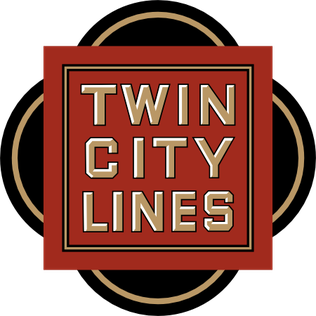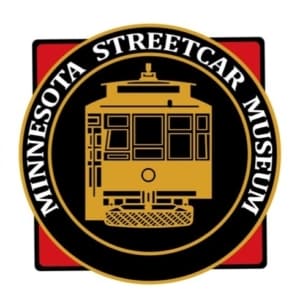


The Lyndale Railway Company later renamed the Minneapolis, Lyndale, & Minnetonka Railway Company operated the Minneapolis, Lyndale and Lake Calhoun railway, also known as the Motor Line.



The Lyndale Railway Company later renamed the Minneapolis, Lyndale, & Minnetonka Railway Company operated the Minneapolis, Lyndale and Lake Calhoun railway, also known as the Motor Line.
The Lyndale Railway Company built a railroad, which began at First Avenue and Nicollet Avenue in downtown Minneapolis and led west along present day 31st Street across Hennepin Avenue, turned then southwest and ended at Lake Calhoun. West of Hennepin Avenue the line ran on a curving private right of way. The company also built a pavilion on the banks of the lake near the terminus of the railroad. [1]
The 4.5 miles (7.25 km) long 3 ft (914 mm) narrow gauge line was inaugurated in 1879. [2] Two 0-4-2 steam engines enclosed in streetcar-like wooden bodies towed short trains along the track. In 1880, the line was extended to Lake Harriet and in July 1882 to Excelsior on Lake Minnetonka. It provided transportation for the tourists that wanted to relax at the shores of the lakes.
In December 1885, the company experimented with electrification using a system from Charles Van Depoele, but decided that this was not yet mature enough, because the electric motors in the prototype vehicles vibrated heavily and due to other mechanical problems. In 1886, the railroad began running soda motors manufactured by Baldwin Locomotive Works in Philadelphia, reportedly the first (and possibly the only) such engines to be built in the United States, it seems that others may have been imported previously for use along elevated rail lines in New York City.

The company, however, was never profitable, and when the lake tourist traffic declined, it was sold in 1886 to James J. Hill's St. Paul, Minneapolis, & Manitoba, a predecessor of the Great Northern Railway. The track was re-gauged to standard gauge and extended to Hutchinson, but the line from Lake Harriet to Hopkins was taken out of service. The steam locomotives were unpopular in the city, which reduced the profitability further so that it was leased in 1887 to the Minneapolis Street Railway. Service was further trimmed back to Lake Calhoun and the Lake Harriet-Excelsior line was abandoned. [3]
Munn, M. D.: Articles of incorporation, by-laws, and ordinances of the Twin city rapid transit co., Minneapolis street railway co., Minneapolis & St. Paul suburban railway co., St. Paul city railway co. 1899 (catalog entry).

Excelsior is a city in Hennepin County, Minnesota, United States. Excelsior's historic commercial district along Water Street is listed on the National Register of Historic Places, and the town has many Victorian-era houses. On Lake Minnetonka's southern shore, the community serves as a local tourism destination for shoppers, boaters, and restaurant-goers.

Wayzata is a city in Hennepin County, Minnesota, United States. The population was 4,434 at the 2020 census. The city is about 12 miles west of Minneapolis and is situated on the northern shore of Lake Minnetonka, the ninth largest lake in the state.

A heritage railway or heritage railroad is a railway operated as living history to re-create or preserve railway scenes of the past. Heritage railways are often old railway lines preserved in a state depicting a period in the history of rail transport.

The Twin City Rapid Transit Company (TCRT), also known as Twin City Lines (TCL), was a transportation company that operated streetcars and buses in the Minneapolis-St. Paul metropolitan area in the U.S. state of Minnesota. Other types of transportation were tested including taxicabs and steamboats, along with the operation of some destination sites such as amusement parks. It existed under the TCRT name from a merger in the 1890s until it was purchased in 1962. At its height in the early 20th century, the company operated an intercity streetcar system that was believed to be one of the best in the United States. It is a predecessor of the current Metro Transit bus and light rail system that operates in the metro area.

William Smith King was a Republican U.S. Representative for Minnesota from March 4, 1875, to March 3, 1877. He was a journalist and businessman. He is best known for allegations of political corruption during this congressional term. The House of Representatives did not specify his offense, but decided it was constitutionally unable to punish him for actions that took place before he entered Congress. He did not run for reelection.

Nicollet Avenue is a major street in Minneapolis, Richfield, Bloomington, and Burnsville in the U.S. state of Minnesota. It passes through a number of locally well-known neighborhoods and districts, notably Eat Street in south Minneapolis and the traffic-restricted Nicollet Mall in downtown Minneapolis.

The Minnesota Transportation Museum is a transportation museum in Saint Paul, Minnesota, United States.

The Como-Harriet Streetcar Line (CHSL) is a heritage streetcar line in Minneapolis, Minnesota, which follows original streetcar right-of-way between Lake Harriet and Bde Maka Ska and is operated by the Minnesota Streetcar Museum. The heritage line was originally developed in the 1970s by the Minnesota Transportation Museum which spun off streetcar operations in the winter of 2004–2005.

Thomas Lowry was an American lawyer, real-estate magnate, and businessman who oversaw much of the early growth of the streetcar lines in the Twin Cities area of Minneapolis, St. Paul, and surrounding communities in Minnesota. He became head of the Minneapolis Street Railway Co., later to become part of Twin City Rapid Transit (TCRT). He is not known to be a relative of Sylvanus Lowry, the slaveholder and profiteer of slavery-related enterprise from St. Cloud, Minnesota.

Uptown is a commercial district in southwestern Minneapolis in the U.S. state of Minnesota, that is centered at the intersection of Hennepin Avenue and West Lake Street. It has traditionally spanned the corners of four neighborhoods, Lowry Hill East, East Bde Maka Ska, South Uptown and East Isles neighborhoods, which are all within the Calhoun Isles community. Historically, the boundaries of Uptown are Bde Maka Ska to the west, Dupont Avenue to the east, 31st Street to the south, and 28th Street to the north; though these borders often vary. Uptown is a popular destination for retail, nightlife, and cultural events, and the district was famously written about by recording artist Prince.

Lowry Hill East, also known as the Wedge because of its wedge-like shape, is a neighborhood in southwest Minneapolis, Minnesota, United States, part of the Calhoun Isles community. It is bounded on the east by Lyndale Avenue, on the west by Hennepin Avenue and on the south by Lake Street. Lyndale and Hennepin intersect on the northern side at Interstate 94. This creates a neighborhood roughly triangular in shape.

Lake Street is a major east-west thoroughfare between 29th and 31st streets in Minneapolis, Minnesota United States. From its western most end at the city's limits, Lake Street reaches the Chain of Lakes, passing over a small channel linking Bde Maka Ska and Lake of the Isles, and at its eastern most end it reaches the Mississippi River. In May 2020, the Lake Street corridor suffered extensive damage during local unrest following the murder of George Floyd. In August of the same year, city officials designated East Lake Street as one of seven cultural districts to promote racial equity, preserve cultural identity, and promote economic growth.

The Minnesota Streetcar Museum (MSM) is a transport museum that operates two heritage streetcar lines in Minneapolis, Minnesota, and the western suburb of Excelsior.

Minnehaha is a steam-powered excursion vessel on Lake Minnetonka in the U.S. state of Minnesota. The vessel was originally in service between 1906 and 1926. After being scuttled in 1926, Minnehaha was raised from the bottom of Lake Minnetonka in 1980, restored, and returned to active service in 1996. The vessel operated uninterrupted on Lake Minnetonka until 2019. It is currently stored in a maintenance facility in the town of Excelsior.

Lund Food Holdings, Inc is an American supermarket operator. Headquartered in Edina, it owns the upscale supermarket chain Lunds & Byerlys. The company opened its first supermarkets in the Uptown area of Minneapolis. In 2015, it changed its name from Lunds to Lunds & Byerlys. It operates 28 stores in Minneapolis-St. Paul metro area of Minnesota.
The Minneapolis Streetcar System was a proposed streetcar system for the city of Minneapolis, Minnesota. Extensive studies and plans for the new system were completed in 2007 and presented to the Minneapolis City Council in January 2008; on April 2, 2010, the Council voted to approve the plans and seek funding. On December 21, 2010 the Federal Transit Administration granted $900,000 to further study the Nicollet and Central Avenue corridors. In June 2021, after no further development on the system, a bill authorized the Metropolitan Council to use funds collected for the Nicollet-Central line to be spent on bus rapid transit funding.

The Marq2 transit corridor is a north–south thoroughfare in Minneapolis, Minnesota, United States. It consists of the parallel streets of Marquette and Second avenues in the downtown area. Each public streetway has two contraflow bus lanes with two lanes available for general-purpose traffic in the opposite direction. Vehicular transit flows south on Marquette Avenue and north on Second Avenue. The inner curb lane allows buses to stop for riders, while the second bus-only lane allows buses to pass each other along the corridor. Bus routes that operate on the corridor stop at every other block at an assigned gate with each route assigned a northbound and southbound gate. Gates are assigned letters A, B, C, or D on Marquette Avenue and E, F, G, and H on Second Avenue. Custom bus shelters are installed at each stop with heaters and real time transit information. The corridor primarily serves express buses operated by all five public transit agencies in the Twin Cities.